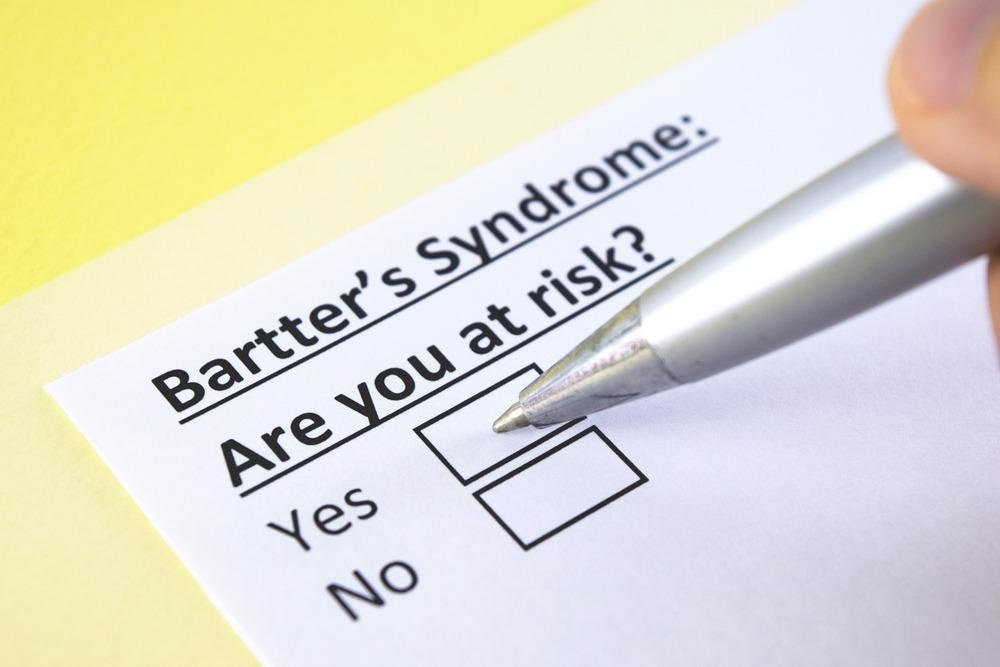What is Bartter syndrome?
Bartter syndrome refers to a set of rare genetic disorders characterized by distinct kidney function abnormalities. These flaws impede the kidney's ability to reabsorb salt, resulting in electrolyte and fluid concentration abnormalities throughout the body. Mineral salts including potassium, calcium, magnesium, sodium, and chloride are among the electrolytes that are impacted.
Bartter syndrome symptoms and severity differ from person to person and can be moderate to severe. Overt symptoms may appear at any age, from before birth through adulthood. Changes (mutations) in one or more genes cause Bartter syndrome.

Image Credit: Yeexin Richelle/Shutterstock.com
Causes and classification
Recessive mutations in the genes produce Bartter syndromes. Bartter syndrome is mainly divided into five sub-types. Mutations in the sodium chloride/potassium chloride cotransporter gene (SLC12A1) cause Type I. Mutations in the KCNJ1 gene cause Type II. Mutations in the chloride channel gene (CLCNKb) cause Type III.
Loss-of-function mutations in the gene encoding barttin lead to Type IV. Mutations in the extracellular calcium ion-sensing receptor and the genes encoding the chloride channel subunits is responsible for Type V.
Signs and symptoms
Among people who have the same subtype, the age of start, severity, and specific symptoms linked with Bartter syndrome can differ significantly. Some people may have minor cases, while others may have serious, potentially life-threatening delivery problems. Bartter syndromes types I, II, IVa, and IVb are linked to a younger-onset (before birth) and more severe symptoms.
Bartter syndrome type III can manifest before birth, albeit with lesser symptoms (see below), and many children with this subtype present with growth issues in infancy or early childhood. Symptoms might be rather diverse. Some people who are impacted may simply have minor symptoms. Muscle weakness, cramps, spasms, and weariness are all common complaints.
Polydipsia (excessive thirst), polyuria (excessive urine), and the need to urinate at night (nocturia) are possible symptoms. Despite drinking enough water, frequent urinating can cause dehydration. Constipation, vomiting, a raised body temperature, lethargy, and an overall sensation of ill health are all possible side effects.
Children's growth rates may be slower than predicted for their age and gender as they get older (growth retardation). If left untreated, impacted people may grow up to be shorter than they would have been as adults (short stature). Some children may have difficulties meeting developmental milestones (developmental delays).
The prenatal Bartter syndromes, also known as Bartter syndromes I and II, and Bartter syndromes IVa and IVb, have signs and symptoms that can be noticed before birth (antenatal period). Excessive urine production and an inappropriate buildup of amniotic fluid surrounding the growing fetus can result from faulty kidney function in utero (polyhydramnios). Premature birth is common. Affected newborns may endure excessive urination (polyuria) as well as life-threatening fever and dehydration during the newborn period. Vomiting and diarrhea are other possible side effects.
Bartter type V is a unique kind that appears as an excess of amniotic fluid (polyhydramnios), which is usually severe and leads to premature birth. Prematurity can occur so early in pregnancy that the infant is unable to survive outside the mother's womb. Despite this, all kidney symptoms of increased urine production and electrolyte loss resolve naturally within weeks of birth, requiring no therapy. Because the gene that causes Bartter syndrome type V is on the X-chromosome, it affects mostly boys.
A triangularly formed face, prominent forehead, wide eyes, prominent, pointed ears, and a “pouting” expression due to drooping of the mouth corners are all common facial traits in affected infants. These distinguishing characteristics may be absent or so minor that they go overlooked in some circumstances.
Because the auditory nerves' ability to convey sensory input to the brain is disrupted in Bartter syndrome types IVa and IVb, affected infants cannot hear from birth (congenital sensorineural deafness). In some cases, cognitive and motor development are also affected, and children who are impacted may face delays in meeting developmental milestones. This is most likely linked to the level of prematurity.
Epidemiology
Males and females are equally affected by the Bartter disorders. In the general population, they are predicted to affect one in every 100,000 persons. As many cases go untreated or are misdiagnosed, determination of the actual prevalence in the general population is difficult. Individuals of any race or cultural origin can have Bartter syndromes.
Diagnosis and treatment
Identification of characteristic symptoms, a complete patient history, a thorough clinical evaluation, and a variety of specialist tests are used to diagnose one of the Bartter syndromes. Blood tests to detect serum electrolyte levels, specifically potassium, chloride, bicarbonate, magnesium, renin, and aldosterone levels, are used to identify these illnesses. Prostaglandin E2 and urine electrolytes, such as sodium, chloride, potassium, calcium, and magnesium, are detected via urine testing.
Identification of characteristic symptoms, a complete patient history, a thorough clinical evaluation, and a variety of specialist tests are used to diagnose one of the Bartter syndromes. Blood tests to detect serum electrolyte levels, specifically potassium, chloride, bicarbonate, magnesium, renin, and aldosterone levels, are used to identify these illnesses. Prostaglandin E2 and urine electrolytes, such as sodium, chloride, potassium, calcium, and magnesium, are detected via urine testing.
The treatment for the Bartter syndromes focuses on the specific symptoms that each person experiences. There is no cure for these conditions, which necessitate the use of certain nutrients and drugs for the rest of one's life. The mainstay of treatment is re-establishing normal fluid and electrolyte balance in the body. To assist in correct electrolyte imbalances, sodium and potassium chloride supplementation is commonly used.
Intravenous salt and water replenishment may be required for some newborns with severe, life-threatening loop diseases (antenatal Bartter syndromes). Because high levels of prostaglandins worsen polyuria and electrolyte problems, treatment usually includes indomethacin, ibuprofen, or celecoxib, which inhibits prostaglandin synthesis. Nonsteroidal anti-inflammatory medicines (NSAIDs) are another name for these medications (NSAID). In addition to conventional therapies, drugs that inhibit or block the renin-aldosterone-angiotensin system (RAAS inhibitors) have been used to treat people with Bartter syndromes (adjunct therapy).
Growth hormone therapy has been reported to be effective in the treatment of growth retardation and low stature associated with Bartter syndrome in some cases. Magnesium supplements may be used to alleviate muscle spasms or tetany in people with Bartter syndrome type III. Affected individuals may also be advised to consume potassium-rich meals.
References:
- Bokhari SRA, Zulfiqar H, Mansur A. Bartter Syndrome. [Updated 2021 Sep 8]. In: StatPearls [Internet]. Treasure Island (FL): StatPearls Publishing; 2021 Jan. Available from: https://www.ncbi.nlm.nih.gov/books/NBK442019/
- (2021). Bartter Syndrome. [Online] NIH – National Center for Advancing Translational Sciences. Available at: https://rarediseases.info.nih.gov/diseases/5893/bartter-syndrome
- (2020). Bartter Syndrome. [Online] NIH – U.S Library of Medicine (Medline Plus). Available at: https://medlineplus.gov/genetics/condition/bartter-syndrome/#inheritance
- (2019). Bartter Syndrome. [Online] National Organization for Rare Disorders. Available at: https://rarediseases.org/rare-diseases/bartters-syndrome/
- Cunha, T., & Heilberg, I. P. (2018). Bartter syndrome: causes, diagnosis, and treatment. International journal of nephrology and renovascular disease, 11, 291–301. https://doi.org/10.2147/IJNRD.S155397
Further Reading
- All Rare Disease Content
- Teaching old drugs new tricks – drug repurposing for rare diseases
- What is Agnosia?
- What is Ameloblastoma?
- What is Apert Syndrome?
Last Updated: Jan 10, 2022
.png)
Written by
Emily Henderson
During her time at AZoNetwork, Emily has interviewed over 200 leading experts in all areas of science and healthcare including the World Health Organization and the United Nations. She loves being at the forefront of exciting new research and sharing science stories with thought leaders all over the world.
Source: Read Full Article



